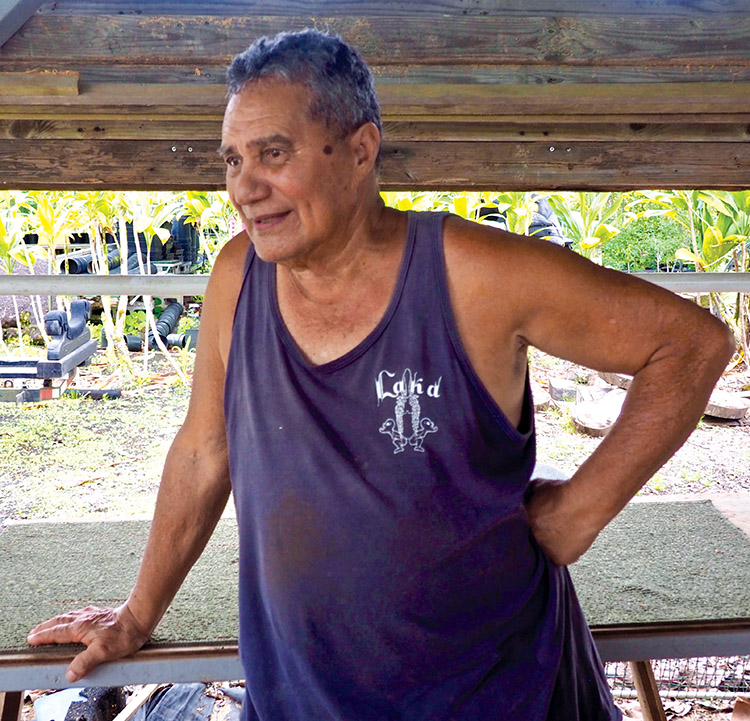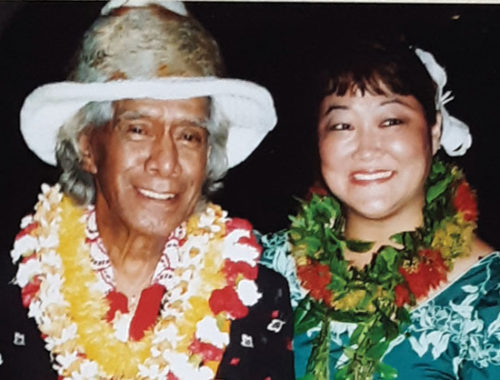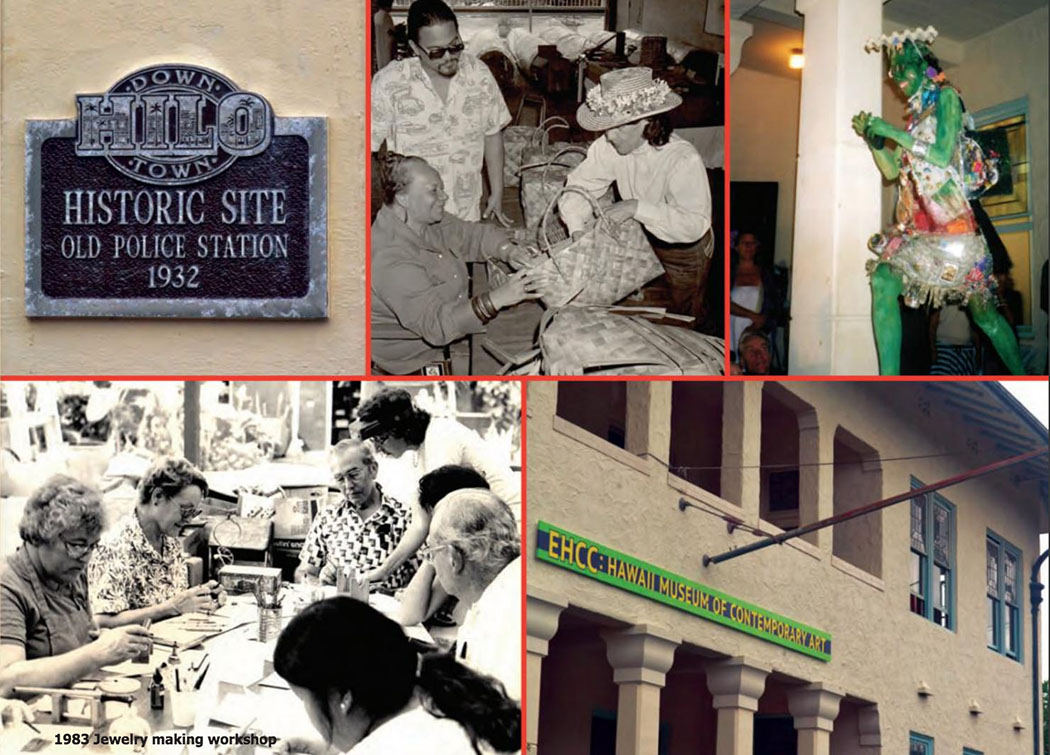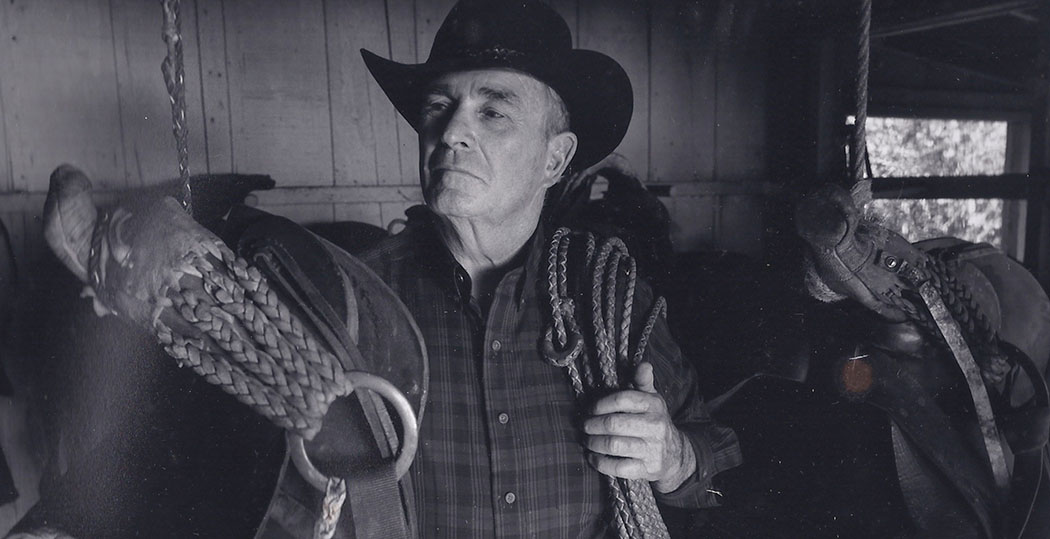
Uncle Billy Paris Talks Story

By Fern Gavelek
He makes the best guava jelly and can sing a mean rendition of “Kona Kai ‘Opua.” Uncle Billy Paris has done many things during his 90 years of life and easily recalls all of them with pinpoint accuracy. The long-time Kona resident loves to “talk story,” sharing with relish early childhood memories, harrowing WWII battles, volcanic eruptions, and challenges he tackled as an adult.
William Hauwawaikaleoonamanuonakanahele Johnson Paris Jr. was born December 18, 1922 at his grandparents’ house on O‘ahu and came to live in Kona when he was three weeks old. His Hawaiian name means “the noise of the birds as they sing in the forest.” Named after his granduncle William Johnson, Uncle Billy claims an impressive lineage.
Billy’s paternal great-grandfather, the Reverand John D. Paris, hailed from Virginia and came to Kona as a missionary in 1841.He built many of the island’s churches. His paternal grandmother, Kailikolamaikapaliokaukini Johnson, was descended from ali‘i nui (ruling chiefs) on Maui. On the maternal side, his grandfather was a Hind and his grandmother a Low, having descended from the Parkers of Parker Ranch.
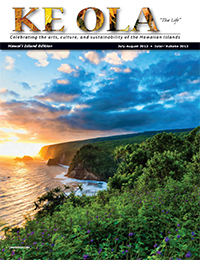
Ranching has been a mainstay in Uncle Billy’s life. He says one of his fondest childhood memories takes place in the saddle.
“I was a youngster of five and a half,” he smiles. “I went with Father on a horse to take the cattle up to the top of Hualālai where we met the cowboys. They took the feeders [cattle] to Pu‘u Wa‘awa‘a Ranch to be fattened because they had good grass. And then we took the Hereford bulls, brought to the top by the Pu‘u Wa‘awa‘a boys, back down to our ranch.”
It was a 17-mile ride “to the top” from where Billy grew up at the W.J. Paris Ranch. The ranch is located in the present-day town of Kainaliu, in the ahupua‘a (Hawaiian mountain-to-the-sea land division) of Lehu‘ula. The Paris family moved into the house in 1926 “after the water tanks were full” with rainwater.
“In the old days, the area was called Honuaino Village,” notes Uncle Billy.
A stickler for using correct place names, Paris emphasizes how the names used today for some towns are really misnomers, having changed for different reasons. “We’ve butchered our names,” he emphasizes.
For example, Uncle Billy cites the town of Captain Cook in Kona. He explains the town got its name because the manager of the Captain Cook Coffee Company offered a spot on the veranda to house the community post office. The company office was located above today’s Napa Auto Parts on Hwy. 11.
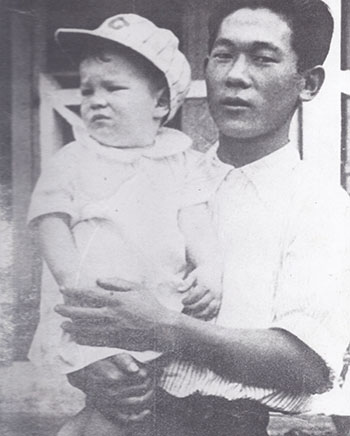
“That area is really Ka‘awaloa, but it came to be called Captain Cook because of the post office,” Billy details, adding he purchased one of his first cars near there—a blue Fairlane—from the Ford dealership located in the current Farm and Garden.
Billy grew up on the Paris ranch, attending grade school at Central Kona Union Church, before entering the boys-only ‘Iolani School on O‘ahu for ninth grade. As a boarder, the young teen got in trouble, and ended up attending Punahou. During high school vacations, the youth returned to the chores of ranching on Hawai‘i Island, traveling via the interisland cattle-freight steamers. He recalls raising ticket money for Easter vacation by winning a game of craps and has all kinds of stories to tell about the shenanigans during the 11-hour trips, adding, “we had a camaraderie on ship.” Billy graduated from Punahou in the “centennial class” of 1941 and enrolled in the University of Hawai‘i (UH) at Mānoa to study agriculture.
And then life as the young man knew it ended on December 7 when the Japanese attacked Pearl Harbor. “We were all members of the ROTC at UH and told to report to the Honolulu Armory,” recalls Billy. He was outfitted “with a rifle, a bandolier of ammunition, a bayonet, and a helmet” and was assigned to guard “municipal installations” like Queen’s Hospital and utility plants.
“I was placed in the Hawai‘i Territorial Guard and then inducted into the U.S. Army in April 1942,” remembers Uncle Billy. He was stationed on O‘ahu’s North Shore for two years in Headquarters Company of the 298th Infantry, working in communications as a telegraph operator and out in the field laying wire.

After attending Armored Officer Candidate School in Kentucky, Platoon Leader Paris was assigned to the 8th Armored Division as a replacement officer and shipped oversees to England, France, and Germany.
Uncle Billy details a battle in the spring of 1945 in Unna, Germany, that earned him and six others a Bronze Star with Valor: “We had just gone through a hell of a winter. The infantry was held up and we couldn’t proceed with tanks because of bazooka fire. I rounded up six volunteers and advanced on foot. We killed the enemy and took 29 prisoners.”
The young officer later earned a Purple Heart when wounded in a tank as part of a reconnaissance unit. He credits his field glasses for saving his life and still has their battered remains to prove it. Billy claims they helped block the shrapnel from his body, though he still carries some in his arm.
“They wanted to send me to the hospital, but instead I commandeered a jeep and proceeded back to my unit and we headed to battle,” he explains. With Billy’s arm in a sling, his unit wiped out the resistance and kept going. “The battle surgeon later picked out field glass bits from my gums.”
After WWII, Paris returned to UH on the GI Bill and was called back to the ranch in 1947 when his father took ill. At that time, the Paris Ranch had 1900 acres that stretched from the mountain down to the sea. The family produced grass-fed beef, plus all their own taro and vegetables.
Uncle Billy tied the knot April 14, 1949, marrying Bertha Herrmann of Honoka‘a. The newlyweds built a house above his parents’ 1926 home and had two daughters, Charlotte and Wilma Jean “Wee-J.”
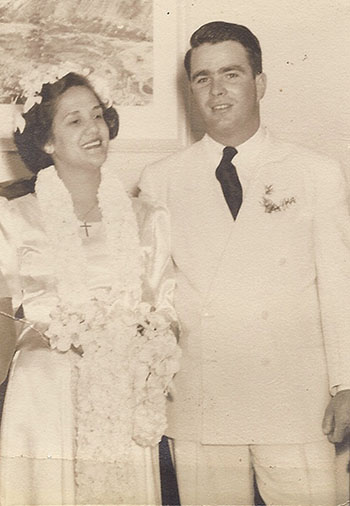
“Lumber was good in those days, it lasted,” says Uncle Billy. “It floated in the ocean to come ashore and that helped season the wood.”
On June 1, 1950, lava erupted from Mauna Loa’s southwest rift zone for 23 days, producing a large and spectacular display, see map*. Billy refers to the volcanic episode as “Kona’s three lava flows,” saying he was eating dinner when he spied a red glow. “It was overcast and we couldn’t see the mountain’s shape, but then all of a sudden we saw lava coming down the mountain…we jumped in the car because we knew somebody [who] lived out that way.”
By the time the Parises got to the area where the lava crossed Hwy 11 (a few miles south of Kealia Ranch headquarters), the flow was already spilling into the ocean. The rapidly moving Honokua lava flow had covered 24 km in less than three hours. They found their friend, Connie Collins, in a bathrobe carrying her dog; her house was destroyed.
A member of the National Guard, Uncle Billy was asked to plot the lava flows and says their plane was “tossed around like a hayseed in the wind” as the earth was still hot.
After William Johnson Sr. regained his health, Billy was called to help out his mother’s family at Pu‘u Wa‘awa‘a Ranch. He was familiar with the ranch, having worked there in the summers as a teen. So in 1956, Billy left to work on the northern flank of Hualālai at Pu‘u Wa‘awa‘a near Pu‘uanahulu.
During droughts, water for the ranch was hauled from Waimea so Paris went to work improving the water distribution system with a larger, 6,000-gallon tank and a pump station. He also increased the calf crop (animals sold as calves to be grown elsewhere).
“I’m proud I was able to get maximum production from the workforce,” says Uncle Billy. “I had a whiz Japanese mechanic and carpenter, but the bulk of the workers were Hawaiians and not too happy when I got there.” Paris was able to get them a salary increase “and paint and lumber to fix their homes.” He worked there for three-and-a-half years and then the ranch was sold.
“When I went, the ranch was in the red,” notes Billy. “When I left, it was in the black.”
Back at the Paris Ranch, Billy was tasked right away with repairing fences and making water holes to catch rainwater as it flowed down the mountain. “In the old days, the mean rainfall at the ranch was 60 inches, but [we’d] gone through a series of droughts and it made us cut back on our cattle-carrying capacity,” he shares.
In 1968, it came to Billy and Bertha’s attention that things weren’t going well at Konawaena School. Teachers were coming and going like a revolving door and Charlotte’s seventh grade teacher couldn’t adequately answer questions in the classroom. “The teacher told her to see me for the answers—imagine that!” exclaims Uncle Billy. So he went to see the principal and Bertha called the Department of Education. Soon Mrs. Paris spearheaded a committee to get the school schedule changed.
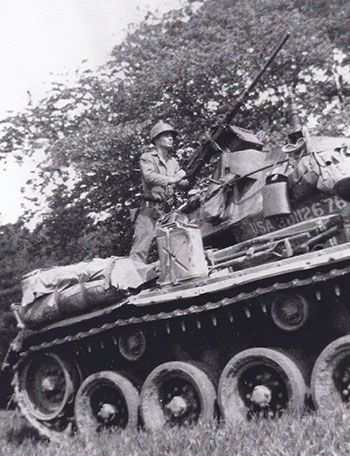
Since 1932, Kona students had been attending school on a custom “coffee” schedule so they could help during the harvesting season. School vacations were August to November, instead of June to September.
“Bertha gave a lot of time to the effort,” explains Uncle Billy. “The coffee farmers, they resisted at first, but were persuaded to do it for the kids.” In 1968, Kona schools changed to a “normal” schedule, following the rest of the state. “We could finally field a football team and recruit better teachers,” added Billy.
Community service has been a big part of Uncle Billy’s life. He recently was named kahu at Lanakila Church, where he served as a deacon for many years. As director of the Kona Soil and Water Conservation District, Billy worked on flood control projects and helping ranches build reservoirs. While president of the statewide Hawai‘i Cattleman’s Council, he lobbied in Washington D.C. for the Beef Imports Act, which limited beef imports into the U.S. While in the nation’s capital, he was asked by Hawai‘i Congressman Cecil Heftel to advocate for the state’s sugar industry—which he did successfully. Active in county government, Uncle Billy helped establish the Hele-On Bus as a member of the transportation commission.
Other endeavors that have kept Uncle Billy busy include serving as managing partner of a limited land partnership that has educated families and children and helped them build homes. “I’m proud of the result; I only wish I had studied business or business law, in college,” he confides. “Then I wouldn’t have needed a lawyer in one hip pocket and a CPA in the other.”
“I’ve had a wonderful life,” Uncle Billy muses. “And I was married to a wonderful gal for 53-and-a-half years (Bertha passed away in 2002). I give her credit—I was a wild character.” ❖
Uncle Billy Remembers…
… The first time I went to Hilo was in 1927 and it took 13 hours and two flat tires.
… We made our own toys: bows and arrows.
… Getting scarlet fever from a “carrier” at the old Okazawa Hall (located at today’s Oshima’s parking lot). I was bedridden for almost six months and it left me with a “conditioned” heart that was back to normal by the time I was 10. Then I could do football, basketball, and track.
… In first grade I was talking to somebody and Miss Holly swatted me with a ruler. I swore at her, with quite a choice vocabulary that I had learned from the cowboys, and it shocked that poor teacher. She called my mother and Mom was waiting with a peach switch.
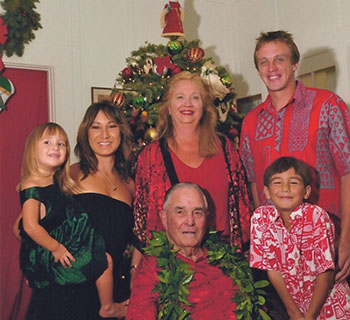
Elle Paris, Lehua Greenwell, Wee-J
Paris, Willie Greenwell, Uncle Billy Paris, and Makamua Paris, 2012
… When eight cars would go by in an hour; now eight cars go by in a few seconds.
… We thought nothing of walking to the ocean from the ranch.
… When the only mauka paved road in Kona was from Hōnaunau to the Palani Junction.
… During the Depression years, Waipi‘o Valley was a great poi-making area. People would hide liquor under poi bags for delivery to houses. Cowboys had a loose step where the delivery boy would hide the hooch.
… Being 15 years old and pulling my first steer into the water at Keauhou Bay for shipping.
… Driving cattle from Palika (Paris) Ranch to Ka‘awaloa on the main highway and car drivers would help by pulling aside to block driveways.
… How paniolo from all the ranches communicated in Hawaiian.
… When you knew just about everybody in Kona and a heck of a lot of people in Hilo.
… Growing 17 varieties of taro and 32 varieties of sweet potatoes.
… Travel among islands for students was on three different freighters and when you went steerage, it was a hell of a ride. Cattle were the principal cargo. Two of the boats had slot machines. There were parked cars and empty staterooms and we had a ball—it was an easy place to get into trouble.
… I loved to party before I married Bertha. I was a target for quite a few women—they always wanted to shilly up to me.
… I went back to my 10th high school class reunion with Bertha. Everyone was on the dance floor with their old girlfriends and finally, Irma Chillingsworth asked me to dance the hana pau. Oh, we danced away and Bertha was so mad. After that, I toned down.
*MapCarta.com/24058058
Contact writer Fern Gavelek: ferng@hawaii.rr.com
